Updated: 22-Jan-2018
Around 1910, this well-known automobile construction company built two types of engines, one of two horizontally opposed cylinders and another one of 4 urpright inline cylinders. After that they made them air cooled.
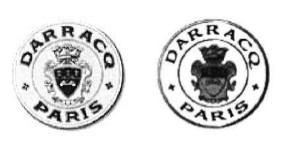
“Two Darraq-Paris logos”
-All of them giving equally satisfactory results. It seems that Darracq's active life was between 1896 and 1920.
-The water-cooled two-cylinder was presented at the Meeting of Reims, mounted on Nieuport monoplanes. Perhaps his most famous installation was when Santos Dumont installed it on his Demoiselle.
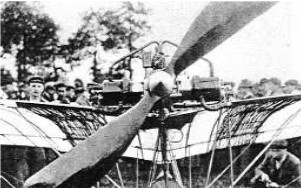
“Darracq, on Demoiselle”
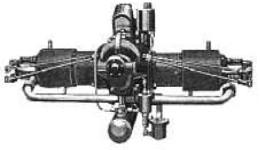
"Darracq water-cooled"

"Darracq cutaway"
-Above we show the water-cooled Darracq as cutaway and below the one exhibited at the Budapest Museum.
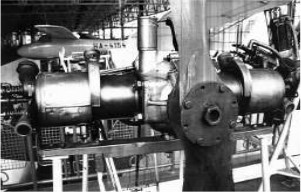
“Darracq en Budapest”
-It had red copper linings, you can see the seams.
-In the picture below we see the position of the inclined magneto and the distribution mechanism is driven by the same shaft.

"Darracq, side view with accessories"
-More images of the 30 CV two-cylinder engine have been obtained lately.
-Used on Santos Dumont's Demoiselles, they have, as it is said in the previous text, the magnet tilted on the engine, coinciding its gear with the end of the crankshaft.
-In turn, the drive shaft of the magneto contains the cams that lift the rods for the intake and exhaust valves.
-Opposed to the magneto is the water pump. See pictures below.

"Darracq 30 CV two-cylinder engine"
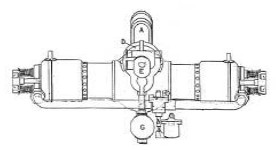
"Schematic diagram, rear view"
-In this figure and the following in details, we have that G is the oil tank, O is the oil pump shaft, and E the water pump.
-A is the magneto, P the camshaft and driven pinion, while the "driver" is the Q at the end of the crankshaft.
-We also see that the cylinders have exhaust ports at the end of the stroke and that there are two intake valves per cylinder.
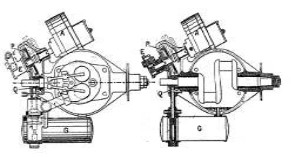
"Two side schematics of the Darracq engine"
-The liquid-cooled, two-cylinder engine is known to give a power of 25/30 CV at 1,500 rpm. It weighed 121 pounds and was manufactured between 1907 and 1914. It had simple ignition.
-There existed the same engine with four cylinders and 50 to 60 CV at the same revolutions. It was built between 1909 and 1914.
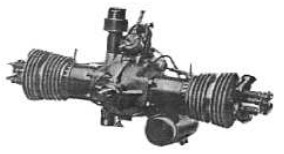
"Darracq 2-cylinder, air-cooled"
-In the air-cooled version, we see some ports just below the fins, at the BDC as an exhaust aid. The diameter of the pistons was 130 mm by 120 mm of stroke, giving 25 CV at 1,300 rpm.
-In addition there is an exhaust outlet at the cylinder head and an intake port.
-Due to the suppression of cooling water, this engine weighed barely 50 Kgs. (The water-cooled one that was used by Santos Dumont weighed 56 Kgs).

"Four-cylinder Darracq engine"
-The inline four-cylinder engine had fully mechanized cylinders, weighing 250 Kgs, with a piston diameter of 170 mm by 140 mm stroke.
-Darracq built other engines under license during the First World War like the Salmson Canton-Unne.
-Later, as from 1920, they build engines under the name of Darracq-Coatalen (see Sunbeam).
-Del Gnome Rhone they made 2,500 engines of the 23,000 units that were built in France and a total of 35,000 in the world.
From Appendix 10: Standing out the long and high intake manifolds, ideal for condensing moisture on the outside (small droplets) due to the cold air/fuel mixture that circulates rapidly inside.
-This doesn't seem a good solution.
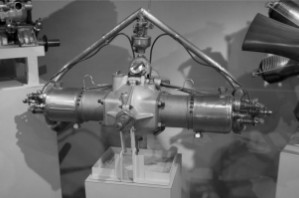
"The mentioned Darracq engine"
-But if this happened in the early twentieth century, the strange thing is that now appears an adaptation of the Chevrolet Corvair engine with long intake ducts whose behavior seems to be the same as the Darracq. Unless there is some "heating" of some kind.
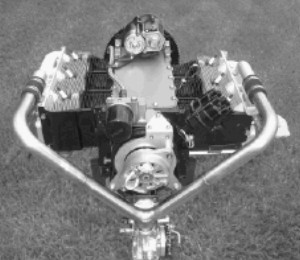
"The modern Corvair engine adapted for aviation"
Engines of DARRACQ
Model: 4 cils. en linea
Arquitecture: 4-cylinder In-line
Cooling:
Total Displacement: Unknown
Bore / Stroke: 170 x 140 mm
Power: Unknown
Weight: 250 Kg

"4-cylinder Darracq engine"
Model: Darracq-Coatalen (Sunbeam)
Arquitecture:
Cooling:
Total Displacement: Unknown
Bore / Stroke: Unknown x Unknown
Power: Unknown
Weight:
Model: Gnome-Rhone (Lic.)
Arquitecture:
Cooling:
Total Displacement: Unknown
Bore / Stroke: Unknown x Unknown
Power: Unknown
Weight:
Model: Salmson/Canton-Unné (Lic.)
Arquitecture:
Cooling:
Total Displacement: Unknown
Bore / Stroke: Unknown x Unknown
Power: Unknown
Weight:
Model: Twin-flat, agua
Arquitecture: 2-cylinder Horizontally opposed
Cooling: Liquid
Total Displacement: Unknown
Bore / Stroke: Unknown x Unknown
Power: 30 CV @ 1500 rpm
Weight: 121 Lb

"The mentioned Darrecq engine"
Model: Twin-flat, aire
Arquitecture: 2-cylinder Horizontally opposed
Cooling: Air
Total Displacement: Unknown
Bore / Stroke: 130 x 120 mm
Power: 30 CV
Weight: 50 Kg

"Air-cooled, 2-cylinder Darracq engine."


